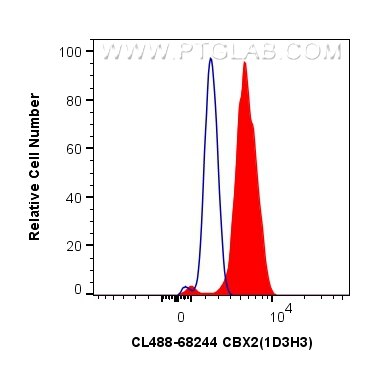Tested Applications
| Positive FC (Intra) detected in | HEK-293 cells |
Recommended dilution
| Application | Dilution |
|---|---|
| Flow Cytometry (FC) (INTRA) | FC (INTRA) : 0.80 ug per 10^6 cells in a 100 µl suspension |
| It is recommended that this reagent should be titrated in each testing system to obtain optimal results. | |
| Sample-dependent, Check data in validation data gallery. | |
Product Information
CL488-68244 targets CBX2 in FC (Intra) applications and shows reactivity with Human samples.
| Tested Reactivity | Human |
| Host / Isotype | Mouse / IgG1 |
| Class | Monoclonal |
| Type | Antibody |
| Immunogen | CBX2 fusion protein Ag8311 Predict reactive species |
| Full Name | chromobox homolog 2 (Pc class homolog, Drosophila) |
| Calculated Molecular Weight | 56 kDa |
| Observed Molecular Weight | 65-70 kDa |
| GenBank Accession Number | BC004252 |
| Gene Symbol | CBX2 |
| Gene ID (NCBI) | 84733 |
| RRID | AB_3084454 |
| Conjugate | CoraLite® Plus 488 Fluorescent Dye |
| Excitation/Emission Maxima Wavelengths | 493 nm / 522 nm |
| Form | Liquid |
| Purification Method | Protein G purification |
| UNIPROT ID | Q14781 |
| Storage Buffer | PBS with 50% Glycerol, 0.05% Proclin300, 0.5% BSA, pH 7.3. |
| Storage Conditions | Store at -20°C. Avoid exposure to light. Stable for one year after shipment. Aliquoting is unnecessary for -20oC storage. |
Background Information
The chromobox homolog protein 2 (CBX2) is a critical component of the PRC1 complex involved in antiviral innate immunity, neuronal, and gonadal differentiation, axial patterning during embryonic development, cell proliferation, and senescence (PMID: 32870972). CBX2 has 2 isoforms with the molecular mass of 23 and 56 kDa. Sometimes higher molecular weight around 65-70 kDa can also be observed, which may be a modified variant of CBX2.
Protocols
| Product Specific Protocols | |
|---|---|
| FC protocol for CL Plus 488 CBX2 antibody CL488-68244 | Download protocol |
| Standard Protocols | |
|---|---|
| Click here to view our Standard Protocols |



